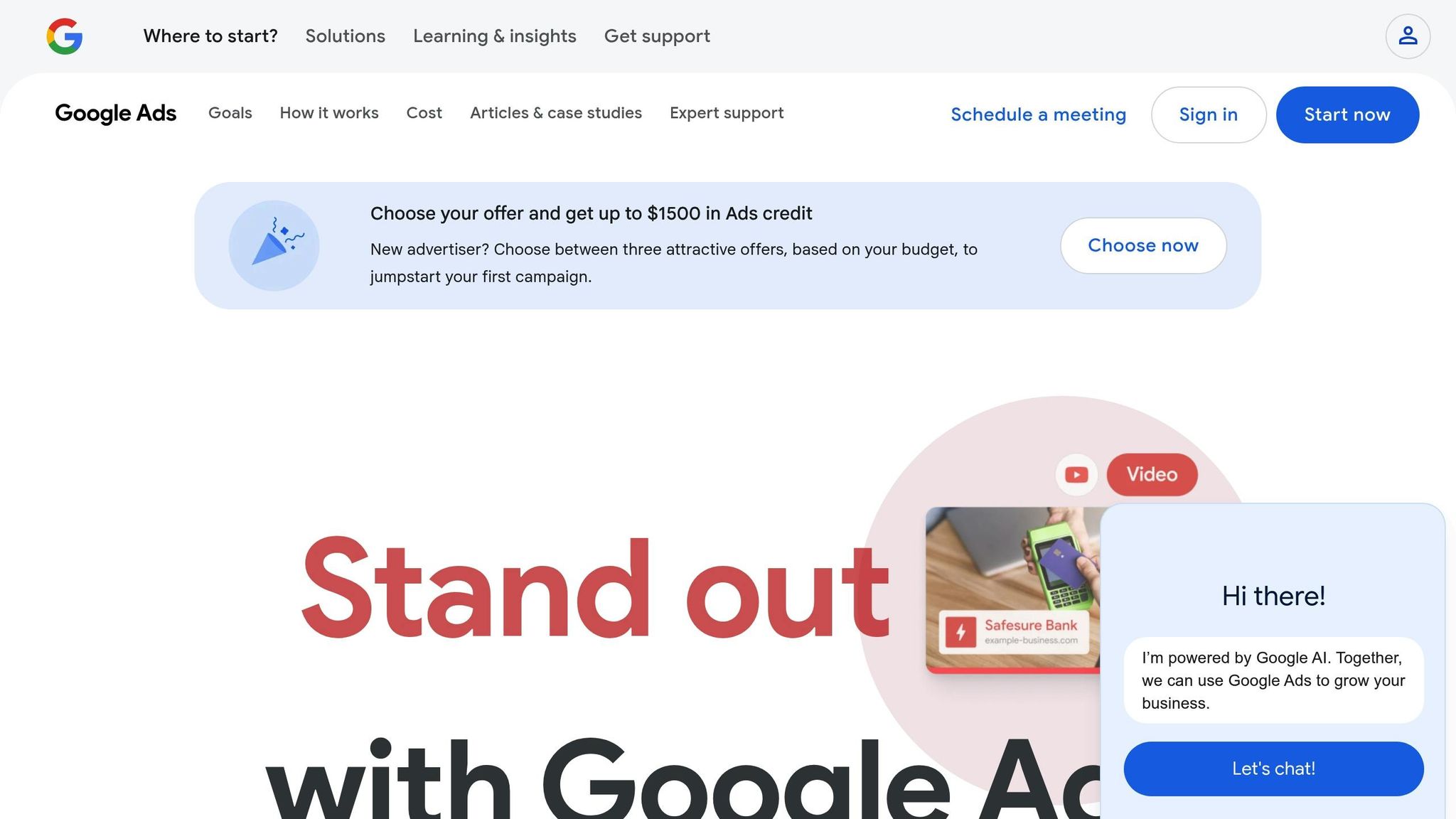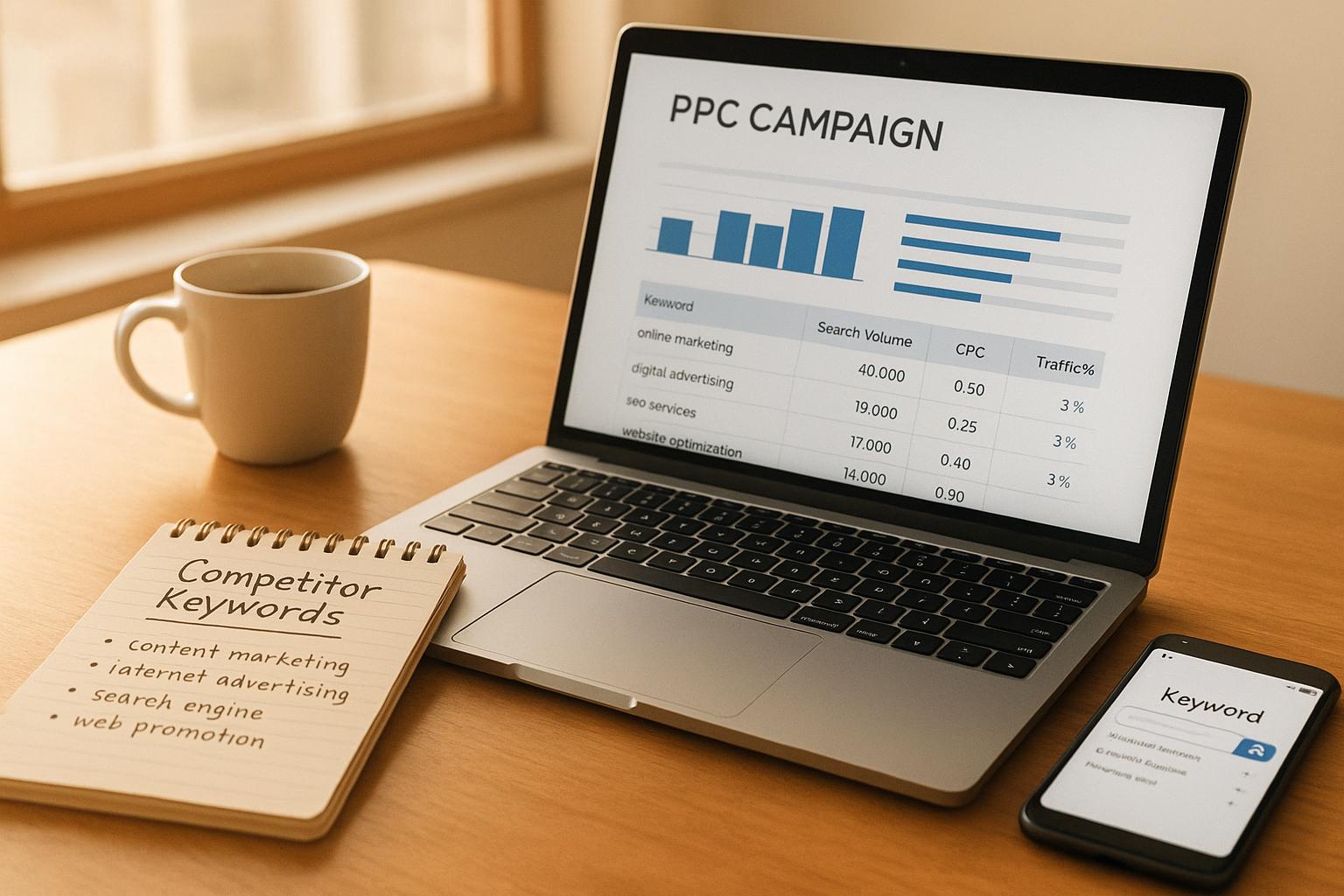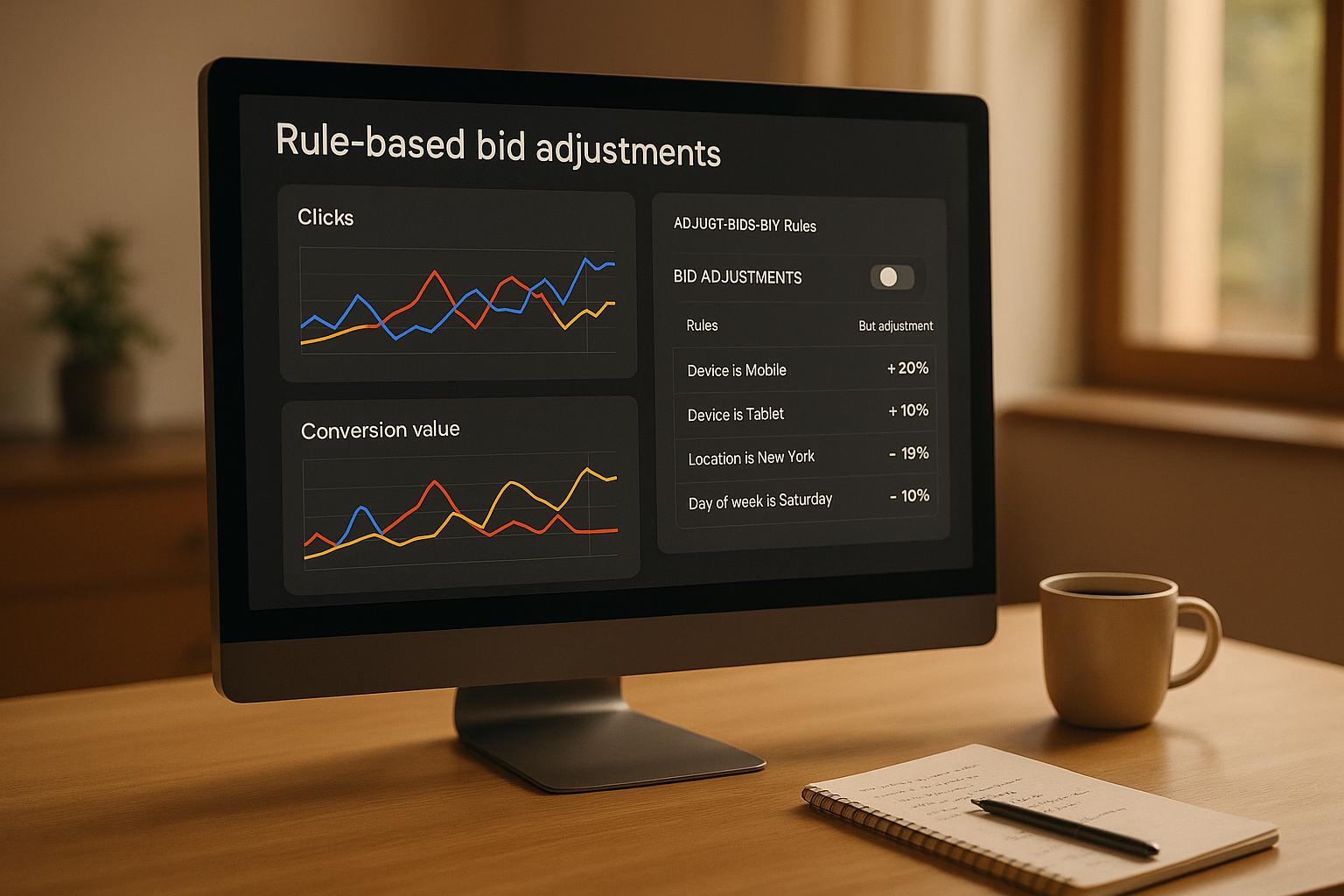Improving your Google Ads Quality Score can lower costs and boost conversions. A key factor? Your landing page experience. Here's a quick summary of the top strategies to optimize your landing page:
- Match Content to Ads and Keywords: Ensure your page aligns with ad messaging and search intent.
- Speed Up Page Loading Time: Faster pages reduce bounce rates and improve user experience.
- Make Pages Mobile-Friendly: Use responsive designs, readable fonts, and touch-friendly buttons.
- Keep Design Simple: Clear layouts and intuitive navigation help users find what they need.
- Create Relevant Content: Address user needs with focused, original content.
- Deliver on Ad Promises: Match offers, visuals, and CTAs to ad expectations.
- A/B Test Elements: Experiment with headlines, CTAs, and layouts to find what works.
- Boost Conversion Rates: Simplify forms and make actions easy to complete.
- Show Trust Signals: Use SSL, trust badges, and clear privacy policies.
- Leverage Data: Use analytics to track performance and refine pages.
These steps help create a better user experience, improve relevance, and ultimately raise your Quality Score. Want to dive deeper? Keep reading for detailed tips and actionable insights.
How to Improve Google Ads Quality Score (I Hit 10/10 for ...

1. Match Landing Page Content to Ads and Keywords
To improve your Quality Score and meet visitor expectations, your landing page content must align closely with your PPC ads. Any mismatch can negatively impact your campaign performance.
Start by incorporating your bidding keywords naturally into key areas of your landing page, such as headlines, descriptions, feature lists, and CTAs. For instance, if you're running ads for "custom kitchen cabinets", make sure this phrase appears prominently in:
- Page headlines
- Product descriptions
- Feature lists
- Call-to-action buttons
Consistency is key. If your ad promises a "30-day free trial of project management software", your landing page should immediately highlight that same offer. This ensures visitors know they’re in the right place.
To address specific search intents, create dedicated landing pages for each ad group. This approach helps visitors find exactly what they’re searching for, improving both your Quality Score and conversion rates.
Focus on these critical elements to align your content effectively:
- Headlines: Include the main keyword and your value proposition.
- Body content: Directly address the pain points or benefits mentioned in your ad.
- Visual elements: Use images that complement and reinforce your message.
- Call-to-action: Match the action promised in your ad.
Relevance goes beyond just using the right keywords. Your landing page must deliver on the expectations set by your ad. Every element should work together to create a seamless experience, which Google rewards with better Quality Scores.
Lastly, conduct regular audits of your landing pages to identify and fix any inconsistencies between your ad promises and the content you’re delivering.
Up next: enhancing page speed to further improve your landing page performance.
2. Speed Up Page Loading Time
Page load speed plays a crucial role in determining your Quality Score. If your landing page takes too long to load, visitors are more likely to leave immediately, increasing bounce rates and hurting your campaign's effectiveness. To improve load times, use reliable optimization methods and consistently monitor performance. Faster load times not only keep visitors on your page but also improve how well your ad messaging connects with them, creating a better overall experience.
3. Make Pages Work Well on Mobile
Improving your landing pages for mobile users is key to boosting your Quality Score. Use a responsive design that works across all screen sizes, ensuring the layout remains clear and easy to navigate. Make sure headlines, forms, and calls-to-action (CTAs) stand out and are easy to interact with.
Here are some tips:
- Touch-friendly elements: Make interactive items like buttons large enough - around 44x44 pixels - for easy tapping. Space them out to avoid accidental clicks.
- Simplified forms: Keep forms short by reducing the number of required fields. Enable auto-fill options, and use mobile-friendly keyboards (like numeric for phone numbers or email-specific layouts).
- Readable fonts: Use a minimum font size of 16px for body text and adjust headlines to be larger, so users don’t need to zoom in to read.
- Optimized images: Compress images and use lazy loading to keep page speeds fast on mobile networks. Modern formats like WebP (with fallback options) can also help improve performance.
Test your landing page on different devices using tools like Google's Mobile-Friendly Test. Focus on the content that appears first (above the fold), so your value proposition is clear and users can take action right away. Avoid pop-ups that disrupt the browsing experience.
4. Keep Design and Navigation Simple
Once your site is optimized for mobile, it's time to focus on creating a clean and straightforward design. A well-organized landing page helps visitors find important information quickly, keeping them engaged and lowering bounce rates. This simplicity can also build trust and improve how Google evaluates your Quality Score.
Here are two key principles to prioritize:
- Clear Visual Hierarchy: Arrange headings, text, and visuals in a logical order so users can process information quickly and easily.
- Intuitive Navigation: Ensure your navigation is simple and guides users directly to the content they need without unnecessary distractions.
A simple, user-friendly layout not only enhances the visitor experience but also aligns with Google's preferences for relevant and credible pages.
5. Create Relevant, Original Content
Craft content that aligns with your ads and meets visitor expectations to improve your Quality Score.
Match Search Intent
Ensure your content matches what users are searching for. For instance, if your ad highlights custom leather wallets, your landing page should focus exclusively on custom leather wallets - not a general selection of leather goods. This kind of focus shows users they’ve landed in the right place.
Develop Unique Value Propositions
Showcase what makes your product or service stand out. Explain how it addresses specific needs, and back it up with key features and customer testimonials. This approach helps build trust and encourages users to take action.
sbb-itb-89b8f36
6. Deliver What Your Ad Promises
Once you've fine-tuned your content relevance and design, the next step is making sure your ad delivers on its promises. Failing to meet expectations can harm your Quality Score and leave customers feeling frustrated.
Match the Offer Details
Whatever your ad promotes - whether it's a "30-day free trial" or a special discount - make sure those details are front and center on your landing page. If visitors have to hunt for the offer or find something different, they'll likely bounce, and your Quality Score will take a hit.
Keep the Visuals Consistent
Your landing page should feel like a seamless continuation of your ad. Stick to the same:
- Brand colors and logos
- Product images
- Key phrases and messaging
- Call-to-action (CTA) text
This consistency reassures visitors that they're in the right place and builds trust instantly.
Highlight Key Information Above the Fold
Make sure the most important details - like the offer, benefits, or features mentioned in your ad - are immediately visible when someone lands on the page. Don’t make users scroll to find what they came for.
Match Call-to-Action Language
Your CTA on the landing page should mirror the wording in your ad. If your ad says "Sign Up Now", don't switch it to "Get Started" on the page. Consistency here keeps users confident and focused on converting.
Simplify Forms
If your ad promises something quick - like a "2-Minute Quote" - your form should reflect that. Keep it short and focused, asking only for the information needed to deliver on the ad's promise.
7. Test Different Page Versions
A/B testing helps fine-tune landing page elements to improve your Quality Score. It builds on your earlier work to align your content and design effectively.
Focus on testing these elements:
- Headlines
- Call-to-action buttons
- Page layout
To get clear results, test one element at a time. For instance, if you're testing your call-to-action button, experiment with different text, colors, or placements while keeping everything else unchanged.
Review the results and apply the changes that perform best to boost conversions and make your landing page more relevant. Keep detailed notes of what works to guide future tests. Regular testing ensures steady progress over time.
8. Improve Conversion Rates
Boosting conversion rates can enhance user experience and improve your Quality Score. One way to achieve this is by simplifying your forms to make them easier and faster to complete.
Ask only for the most necessary information. Add features like auto-fill and progress indicators to make the process smoother. Also, make sure your forms work perfectly on all devices - desktop, tablet, and mobile. These updates help users complete actions quickly, leading to more conversions.
Streamlined forms not only increase conversions but also create opportunities to improve landing page performance and tracking.
9. Show Trustworthiness
Earning visitor trust is key to increasing engagement and improving your Quality Score. Start by ensuring secure payment options and displaying SSL certificates and trust badges prominently. These signals immediately communicate that your site is safe.
Make your privacy policies and terms of service easy to find. Clearly outline how you collect, use, and protect user data, along with any sharing practices. Being upfront about these details builds confidence and shows you value transparency.
Place trust badges and certifications in visible spots to reassure visitors, but ensure they don't distract from your main conversion goals.
10. Use Data and Tools to Track Progress
Keep an eye on how your landing pages are performing by using analytics tools and actionable data. For example, making adjustments based on data has been shown to lower bounce rates and improve conversions in actual campaigns. These metrics help guide testing and quick changes.
- Set Up Analytics Tracking
- Monitor bounce and exit rates
- Track conversions by traffic source
- Examine user behavior patterns
In addition to analytics, A/B testing tools can help you refine specific elements of your landing page:
- Use A/B Testing
- Test individual page elements
- Compare how different versions perform
- Assess the impact on Quality Score
The Top PPC Marketing Directory provides tools that simplify tracking and optimization, making it easier to improve your Quality Score.
Key metrics like bounce rate, time spent on the page, conversion rate, and page load speed are critical. Improving these areas can lead to better results. AI-driven tools for bid management and performance tracking can also reveal opportunities that might be missed through manual efforts.
Conclusion
The strategies outlined above offer a solid framework to improve your landing page performance. By focusing on these techniques, you can lower ad costs and increase conversions. For instance, AdPushup's AI-driven approach in 2023 led to a 30% increase in ad revenue [1].
Key areas to focus on include:
- Technical Performance: Ensure fast loading times and mobile-friendly design.
- Content Alignment: Match your ad messaging and keywords with the landing page content.
- User Experience: Provide easy navigation and persuasive calls-to-action (CTAs).
- Building Trust: Use credibility markers like security certifications and customer reviews.
- Ongoing Improvements: Use data to test and refine your pages regularly.
Landing page optimization isn’t a one-time task. Regularly analyzing performance data and making adjustments is key to staying ahead.
The Top PPC Marketing Directory offers tools and resources for A/B testing, performance tracking, and other optimization methods. These tools can help you implement strategies more effectively and improve your campaign outcomes.


